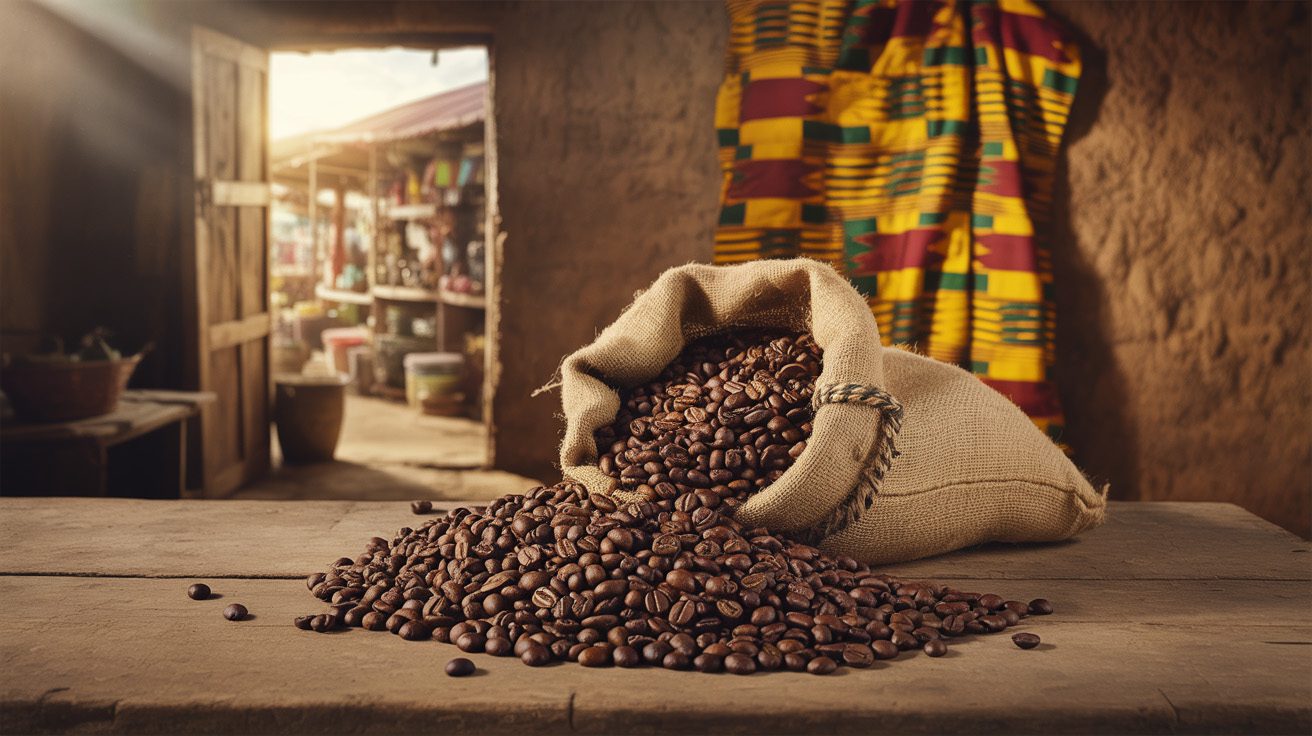Coffee Blog
The Soul of Coffee: A Journey into the Vivid Flavors of Ethiopian and Kenyan Beans

To travel through the world of coffee is to take a global flavor tour. You might find the chocolatey, nutty comfort of beans from Brazil, the balanced sweetness of a Colombian, or the earthy intensity of a Sumatran. But for a true coffee epiphany—a experience that redefines what a cup of coffee can be—you must journey to the birthplace of coffee itself: Africa. And within this continent, two nations stand as titans of taste, producing beans of such breathtaking vibrancy and complexity that they have captivated the specialty coffee world: Ethiopia and Kenya.
These are not your average morning cups. They are sensory adventures. They are the reason a coffee professional might use the word “juicy” to describe a brew or why tasting notes like “bergamot,” “blackcurrant,” and “ripe strawberry” are not just marketing fluff but genuine, discernible flavors waiting to be discovered. This is the story of Ethiopian and Kenyan coffee, a tale of ancient tradition, modern innovation, and the unique terroir that creates the most exciting cups on the planet.
Ethiopia: The Cradle of Coffee’s Wild Heart
Ethiopia is not just a coffee-producing country; it is the spiritual and genetic home of Coffea arabica. The legend of Kaldi, the goatherd who discovered coffee after seeing his goats frolic energetically upon eating red berries from a certain tree, is woven into the nation’s identity. Coffee, or buna, is the heart of Ethiopian social and cultural life, central to ceremonies that can last for hours. This deep, historical connection to the bean is palpable in every cup.
The Terroir: Garden of Eden
Ethiopia’s flavor profile is a direct result of its incredible biodiversity. Unlike the vast, organized estates of Brazil, a huge portion of Ethiopian coffee is grown by smallholder farmers in a “garden” system. Coffee trees are interspersed with other crops like enset (false banana), corn, and beans, under the shade of native forest trees. This natural, polyculture farming method, often organic by default, contributes to a stunningly complex and wild cup profile.
Furthermore, Ethiopia boasts an array of coveted heirloom varieties. This is a catch-all term for thousands of native coffee varieties that have evolved and adapted to their specific micro-regions over centuries. Unlike the single-variety focus of many countries, this genetic melting pot is the source of Ethiopia’s unpredictably beautiful and nuanced flavors.
A Tale of Three Regions:
Ethiopian coffee is broadly categorized by its processing method and region, each offering a distinct experience:
-
Yirgacheffe (Washed): Located within the larger Sidamo region, Yirgacheffe is the crown jewel of washed Ethiopian coffee. The “washed” process, where the coffee cherry’s fruit is removed before the beans are dried, results in a cup of unparalleled clarity and elegance. The signature profile is intensely aromatic and tea-like, with explosive notes of bergamot, lemon, jasmine, and peach. It’s a bright, clean, and uplifting coffee that often tastes more like a citrusy tea than a traditional coffee.
-
Sidamo (Washed and Natural): Coffees from the wider Sidamo region are known for their balanced and vibrant cup. A washed Sidamo might offer a classic, well-rounded acidity with notes of citrus and cocoa, while a natural Sidamo bursts with deeper fruitiness.
-
Harrar (Natural): In the east, the dry, arid climate of Harrar is perfect for the “natural” or dry process, where coffee cherries are dried in the sun with the fruit intact. This method imbues the beans with the fruit’s sugars, creating a coffee that is the polar opposite of Yirgacheffe. Harrars are famously wild, funky, and complex. They are full-bodied and winey, with bold, boozy notes of blueberry, strawberry, and dark chocolate. It’s a bold, unpredictable, and deeply rewarding experience.
Kenya: The Science of a Perfect, Punchy Cup
If Ethiopian coffee is a wild, untamed artist, Kenyan coffee is a precision engineer. Kenya’s coffee industry is renowned for its rigorous, scientific approach to quality, from cultivation to auction. The result is a cup that is consistently bright, intense, and structurally profound.
The System: Auction and SL-Varieties
The Kenyan auction system is a key driver of quality. Coffee is sold to the highest bidder, creating fierce competition that incentivizes farmers to produce the best beans possible. This is complemented by the country’s focus on specific, research-developed coffee varieties, notably the SL (Scott Laboratories) series. Varieties like SL-28 and SL-34 were bred for resistance to drought and disease, but they had a wonderful side effect: they became responsible for Kenya’s signature bright acidity and complex fruit flavors, particularly the blackcurrant note SL-28 is famous for.
The Process: Double Fermentation
Kenyan processing is meticulous. The most common method is the “double wash” or “Kenyan process.” After depulping, the beans are fermented underwater, then washed and fermented again. This intensive process removes all of the sticky fruit mucilage and results in a bean with a spectacular clarity of flavor and a clean, crisp mouthfeel. It accentuates the inherent acidity and allows the complex notes to shine without any murkiness.
The Signature Kenyan Profile:
A high-quality Kenyan coffee is an unforgettable experience. It’s often described as “savory” or “tomato-like” in its aroma, which gives way to a breathtakingly bright and juicy acidity in the cup. The most iconic tasting note associated with Kenya is blackcurrant (or ribena). Beyond that, expect a cascade of flavors: ripe tomato, grapefruit, lemon, blackberry, and even tropical fruit notes like passion fruit. Underpinning this vibrant acidity is a distinct, often tart, tomato-like sweetness and a rich, rounded body. The finish is clean and long-lasting. It’s a coffee that makes your mouth water and demands your attention.
Side-by-Side: A Comparative Tasting
To truly appreciate these two giants, taste them side by side.
-
Ethiopian Yirgacheffe (Washed): You are greeted by a floral and citrus aroma. The cup is light-bodied, tea-like, and incredibly clean. The dominant notes are lemongrass, jasmine, and bergamot. The acidity is bright and sparkling, like a white wine.
-
Kenyan (Nyeri or Kirinyaga): The aroma is more savory and fruity—think tomato vine and blackcurrant. The cup is heavier, with a more syrupy body. The acidity is bold and punchy, not just bright but forceful, leading to flavors of blackcurrant, grapefruit, and a distinct tomato-sweetness. It’s a more structured and intense experience.
One is a ballet, the other is a rock concert. Both are magnificent.
Brewing to Honor the Bean
To do these exquisite beans justice, your brewing method matters. You want a technique that highlights their clarity and complexity.
-
Pour-Over (V60 or Chemex): This is the gold standard for both Ethiopian and Kenyan coffees. The paper filter captures oils and fines, resulting in an incredibly clean cup that allows every nuanced note of floral, citrus, and fruit to sing with clarity.
-
French Press: While it will produce a muddier cup, the French Press excels at highlighting the deep, boozy fruitiness of a natural Ethiopian like a Harrar or the heavy body of a Kenyan.
-
Avoid: Dark roasts and espresso blends. These delicate, complex flavors are easily obliterated by a dark roast. They are best enjoyed as a light to medium roast, where their innate characteristics can truly shine.
A Final Sip
Ethiopia and Kenya offer more than just coffee; they offer a story in every cup. From the ancient, wild forests of Ethiopia where it all began to the meticulous, science-driven farms of Kenya, these beans represent the pinnacle of coffee’s potential. They challenge our preconceptions and reward the curious drinker with a spectrum of flavors far beyond mere “coffee.”
To drink a finely brewed Yirgacheffe or Kenyan is to understand why coffee is considered a craft beverage. It is an invitation to slow down, to smell, to taste, and to appreciate the incredible journey from a high-altitude farm in Africa to your morning mug. It is, in short, the soul of coffee.



 Bee Mugs
Bee Mugs Bird Mugs
Bird Mugs Bunny Mugs
Bunny Mugs Cat Mugs
Cat Mugs Goat Mugs
Goat Mugs Horse Mugs
Horse Mugs Lion Mugs
Lion Mugs Monkey Mugs
Monkey Mugs Moose Mugs
Moose Mugs Owl Mugs
Owl Mugs Sheep Mugs
Sheep Mugs Snail Mugs
Snail Mugs Turtle Mugs
Turtle Mugs Unicorn Mugs
Unicorn Mugs
 Engagement Mugs
Engagement Mugs Retirement Mugs
Retirement Mugs St Patrick’s Day Mugs
St Patrick’s Day Mugs Thank You Mugs
Thank You Mugs
 Boss Mugs
Boss Mugs Christmas Mugs
Christmas Mugs Colleague Mugs
Colleague Mugs Dad Mugs
Dad Mugs Grandad Mugs
Grandad Mugs Grandma Mugs
Grandma Mugs Husband Mugs
Husband Mugs Lawyer Mugs
Lawyer Mugs Nurse Mugs
Nurse Mugs Sarcastic Mugs
Sarcastic Mugs Uncle Mugs
Uncle Mugs Wife Mugs
Wife Mugs
 Fourth of July Mugs
Fourth of July Mugs Halloween Mugs
Halloween Mugs Thanksgiving Mugs
Thanksgiving Mugs Valentines Day Mugs
Valentines Day Mugs
 Amsterdam Mugs
Amsterdam Mugs Barcelona Mugs
Barcelona Mugs Berlin Mugs
Berlin Mugs Chicago Mugs
Chicago Mugs Dubai Mugs
Dubai Mugs London Mugs
London Mugs Paris Mugs
Paris Mugs Rome Mugs
Rome Mugs Sydney Mugs
Sydney Mugs Tokyo Mugs
Tokyo Mugs Toronto Mugs
Toronto Mugs
 Aunt Mugs
Aunt Mugs Boss Mugs
Boss Mugs Boyfriend Mugs
Boyfriend Mugs Co-Worker Mugs
Co-Worker Mugs Couples Mugs
Couples Mugs Gamer Mugs
Gamer Mugs Girlfriend Mugs
Girlfriend Mugs Nanny Mugs
Nanny Mugs Sister Mugs
Sister Mugs Teachers Mug
Teachers Mug
 Baseball Mugs
Baseball Mugs Fishing Mugs
Fishing Mugs Football Mugs
Football Mugs Golf Mugs
Golf Mugs Rugby Mugs
Rugby Mugs Soccer Mugs
Soccer Mugs Tennis Mugs
Tennis Mugs
 Best Man Mugs
Best Man Mugs Bridesmaids Mugs
Bridesmaids Mugs Father of the Bride Mugs
Father of the Bride Mugs Groomsmen Mugs
Groomsmen Mugs Matron of Honor Mugs
Matron of Honor Mugs
 Inspirational Mugs
Inspirational Mugs Offensive Mugs
Offensive Mugs Sexy Mugs
Sexy Mugs